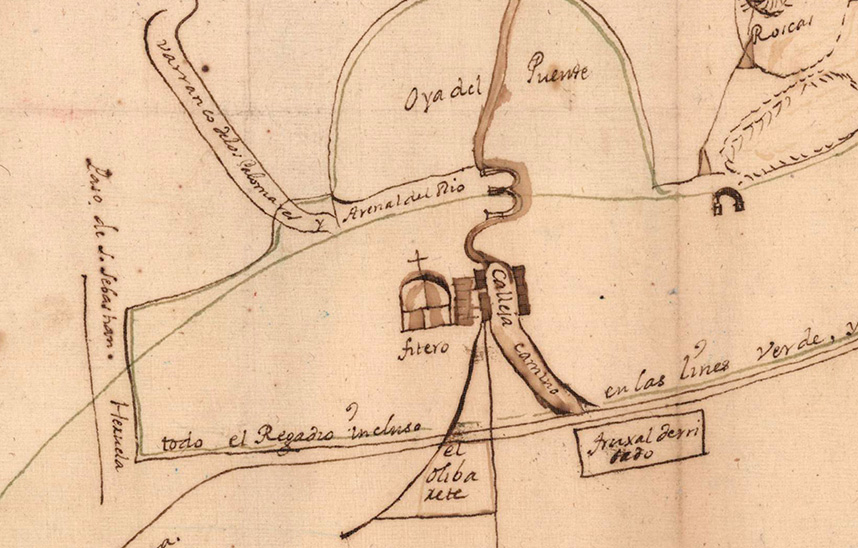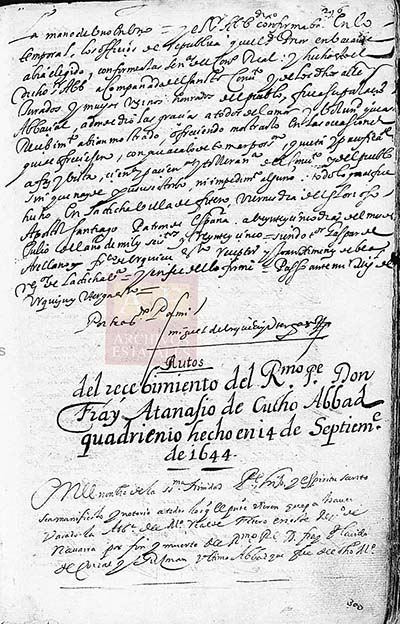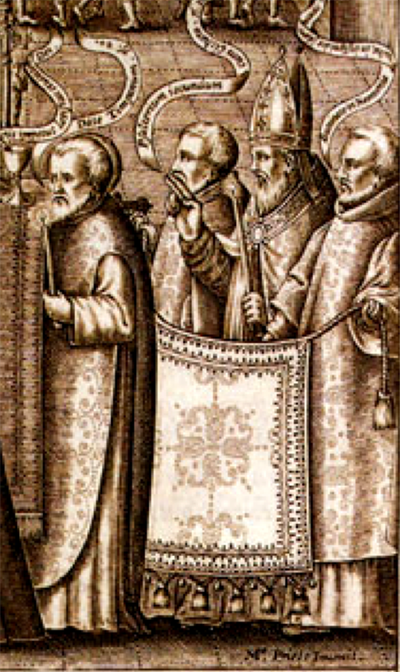The taking possession of the abbots of the monastery of Fitero in the Ancien Régime (I)

Photofile General de Navarra/Detail of the plan of Fitero, c. 1600.
The ceremony of the abbot's inauguration in Fitero, during the centuries of the Ancien Régime, was full of symbolism and perfectly protocolized, from the reception of the prelate in the town, to his installation in the abbey palace.
However, it did not always develop, formally, in the same way. Like other festivals with civic and religious components, it should be noted that we are dealing with a dynamic event, with some basic traditions that were maintained by their own idiosyncrasy, while others were lost, created and even reappeared over time. The playful, the spectacular and the ritual were given quotation with ever-present components such as gunpowder, dances, bells, gestures, costumes, routes, triumphal arches, as well as the reading of the papal bull or the royal decree.
There is a lack of a monographic study of the topic that can be tackled with different sources, from the municipal conference proceedings , the notarial deeds of the takeovers preserved in the archives of Tudela and Tarazona, to their copies in the codices of the National Historical file , and even some lawsuit litigated in the Royal Courts of Navarre. From these lines, we will make an approach to topic.
The appointment of the new abbot was legitimized by the issuance of a papal bull, later a royal decree, documents that acquired great importance in the act, since they were exhibited, checked, read and finally placed on the heads of the mayor, aldermen and other authorities to visualize the very abbot's jurisdiction that was in crescendo throughout that period of the Modern Age.
Regarding the place of reception, there was also a great change. Until the abbots were perpetual, after the death of Fray Plácido del Corral y Guzmán in 1643 and the appointment of the next two abbots who came from outside, the meeting took place outside the monastery and the urban center, in places that were not always the same. From that date until the exclaustration, the ceremony generally took place closer to the town center and with a different ritual.
With the perpetual abbots
The first possession of which we have complete news, in plenary session of the Executive Council XVI century, is that of Fray Martín Egüés II, on July 25, 1540, by the testimony of the notary of Tarazona Jerónimo Blasco. After the religious services and funerals for the previous abbot, the new prelate with the monks went out to place, accompanied by different notables such as micer Martín de Mur, doctor Martín Miguel de Munárriz, Roger Pasquier, justice of Tudela and the aforementioned notary from Tarazona. The mayor and an alderman and other local authorities came to the retinue, who were informed of the death of the previous abbot, for which reason the rods of his authority were taken away, a gesture that was protested because the year of designation had not passed, which was the day of St. Michael. The abbot admitted the complaint, reappointed them and gave them back their rods. Immediately, as lord of the place, he took possession "and in sign of it, he walked and walked through the said silver of the said place and went walking through the streets of the said place accompanied by the said mayor and jurors until he arrived at the gates of the said place, called the one the river gate and the other the gate of Santa Lucia and in sign of true possession, he closed the said gates of the said place and then opened them, all of which he did peacefully and quietly, without impediment, nor contradiction whatsoever ...".

Folio of the notarial protocol of the taking of possession of the abbey by Friar Martín Egüés II in 1540. file de Protocolos de Tarazona.
It was precisely with the abbot Egüés II mentioned above that the abbey obtained the dreamed privilege of nullius diocesis in 1560. From then on, the abbot could display his power and image as such, with numerous privileges, including the right to use "pontifical chair in the church, crosier, mitre, pectoral, ring and guild".
The account of the taking of possession by Friar Marcos de Villalba, in 1590, is rich and has numerous details. The first fact that calls the attention is the denomination of "villa" for Fitero, since half a century before, in the previous inauguration, the designation was of "place". The reception procession was presided over by the prior, Friar Pedro González Navarro, the monks, the mayor and the aldermen, accompanied by the ringing of boxes and dances to the sound of the bells. All of them went out with a raised cross and candles "to the cross that goes to Yerga, which is outside the said town, on the way to Corella". In that place the abbot Villalba was already dressed in pontifical vestments and when they met they sang the Te Deum and the Veni creator. Immediately, the procession was organized to the church, where the Salve was sung. The abbot went up to the main altar and gave the blessing to the congregation and took his seat, ordering Friar Miguel de Beamonte to read the bull in a loud and intelligent voice. Likewise, other documents of jurisdiction and the certification of having blessed the abbot in the capital of Navarre were read. The ceremony continued with the submission of the mayor's rod to the abbot and the return of the same to the mayor. The aldermen and other positions such as the nuncios or the notary were called to question them about who had given them their positions, answering that the previous abbot, after which Fray Marcos de Villalba corroborated them again in their positions.

certificate Atanasio de Cucho's reception as abbot in 1644, first quadrennial abbot, in the Libro Tumbo or Naranjado of the Monastery of Fitero, preserved in the file National Historical Archive.
In the following inauguration and entrance in the town, that of Abbot Ignacio de Ibero, 1593, the bells, music, dances "and other joys" fulfilled their mission statement of bringing joy and rejoicing to the ceremony. Previously, the nuncio had proclaimed the event with drums. Again the prior, subprior, fabriquero and monks with raised cross, candles and candlesticks with the municipal authorities went, in this case to the "Humilladero de la cruz, junto a la puente nueva"(Shrine of the cross, next to the new bridge).
The templete of the mentioned Wayside Cross or humilladero, with a column in the center was erected around 1558. For it, Juan Martínez de Azcoitia left in his will the amount of 20 ducats for the humilladero and Crucifix, which had been made in the place of the Paradero. Its Renaissance Crucifix was replaced by another modern one made in 1947 and blessed in 1948. In the vicinity of this construction was located one of the three gates that gave access to the town, which was demolished in 1845 for being inserted in insignificant fortifications and present serious risks, especially for the carters.

Humilladero de Fitero, place of reception of some of its abbots, c. 1558. Photograph from a century ago. Private collection.
There, in the humilladero, the new abbot was dressed in pontifical vestments and received the greetings of the prior of the monastery, the monks, the monks, the zeroferarios, the officiants, the mayor and the aldermen. They all uncovered themselves and kissed his hand "with all reverence". After intoning Te Deum and Veni creator, they went to the church with "well concerted music", interpreting some motets in his honor. Ignacio de Ibero's taste for polyphony. The monks surely knew it and it will not be superfluous to remember that scores of the great masters such as Palestrina, Cristóbal de Morales, Tomás Luis de Victoria, Fernando de las Infantas and other Italian composers of the first line arrived to the monastery from his hand.
Once in the sacred precinct, the abbot sat in his pontifical chair, the music and chanting ceased, the papal bull of the abbey and lordship was read aloud, and all the monks, dons and novices kissed his hand and paid obeisance, as did the mayor who, kneeling on the steps, handed over his staff, which was returned to him. In the report, it is emphasized that all those ceremonies, full of symbolism, were carried out in the presence of the people. After the blessing, he stripped himself of his pontifical insignia and ornaments and went in and out through the doors of the dependencies, later moving to the abbot's palace. On that occasion, the municipal authorities discussed whether he was to be received as a lord or as a prelate, and the nuncio's decree obliged him to leave for the reception under financial penalties.

Engraving of a bishop with the guild cloth in an engraving by Juan de Courbes, in Psalmodia Eucaristica by Melchor Prieto (Madrid, Luis Sanchez, 1622).
We are not going to repeat what happened in other cases, if only to point out some details of other receptions. In the case of Abbot Felipe de Tasis in 1614, we know the letters exchanged between the municipal authorities and the abbot, as well as a legal opinion requested by the regiment from a legal expert from Tudela. The council met in the cemetery, at entrance of the church, the usual place for their meetings. The councilors went out on horseback to receive him, for which they went to Shrine of Our Lady of Fair Love de la Purísima de Cintruénigo, where Friar Felipe came in a litter, accompanied by the abbot of the monastery of Herrera, other monks and the mayor and councilors of Cintruénigo. After dismounting from the horses and greeting "with much love", upon arriving at the Olivarete, a company of soldiers from the town, with their captain and sergeant and the flag of the brotherhood of San Miguel gave color and solemnity to the act. We have evidence that the ensign of the brotherhood hooped and "bandeted" the aforementioned flag, while the arquebusiers preceded to fire a salvo, creating a moment of climax. Through the Mejorada they went to the Humilladero, inside which the new abbot was dressed with the ornaments and insignia of pontifical and the greetings were made. The abbot of the monastery of Herrera and another monk carried the gremial. The music was of shawms and the singers of the monastery intoned different hymns. In front of the door of the church a great triumphal arch was erected, adorned with many bouquets with allegorical representations of virtues, among them that of justice, in the upper part, with a child in a woman's habit brandishing a sword, who pronounced a harangue in a loud voice. In the main chapel of the church the customary ceremonies were performed, confirming the offices of the monks of the abbey and with the calling of the local authorities and the confirmation in their offices. On this occasion the obedience of the monks was in the abbey palace where the procession was led with the accompaniment of the shawms and soldiers. To commemorate the event, on this occasion, a couple of comedies were performed with their music and hors d'oeuvres, one of the Counts of Altamira and the other of the Battle of Lepanto.
The abbot don Hernando de Andrade wrote to the regiment of Fitero from Ágreda, where he was very tired "by the storms of snows and airs". and arrived on horseback in 1615 by the Dehesa de Valdebaño, also participated the elements of military character before indicated, as well as chirimías. The rest of the ceremonial was as in the cases already described. It should be noted that the abbot's seat was lined with yellow velvet.
The last perpetual abbot, Fray Plácido del Corral y Guzmán, arrived on St. James' Day, 1625, on horseback through the Cascajos. The welcome was in the Humilladero, where the Te Deum was sung, reserving the Veni Creator to be interpreted next to the door of the church. The blessing and acts of obedience took place in the church.
